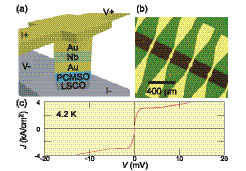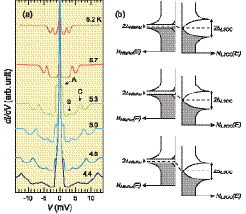Ferromagnetic Josephson Junctions
Lippmaa Group
Ferromagnetism and superconductivity are generally incompatible because in conventional superconductors Cooper pairs are formed by two electrons with opposite spins, while in ferromagnets, exchange interactions align the spins parallel to each other. In our recent work, we study the possibility of a long-range supercurrent surviving in highly spin-selective materials, such as half-metals in spin filter tunnel junctions. In particular, our interest is in determining the role of magnetic disorder in promoting a spin-triplet supercurrent in a superconducting tunnel junction with a ferromagnetic insulator barrier.

Fig. 1. (a) Schematic view of the La1.85Sr0.15CuO4 (LSCO) / Pr0.8Ca0.2Mn0.9Sc0.1O3 (PCMSO) / Au / Nb / Au junction. (b) Image of a patterned junction array. (c) Current-voltage characteristic of a junction at 4.2 K.

Fig. 2. (a) Differential tunneling spectra at various temperatures and (b) proposed band diagrams explaining the origins of the three peaks, A (top), B (middle), and C (bottom) in the tunneling spectra.
The tunnel junctions (Fig. 1a) were grown by pulsed laser deposition and consisted of superconducting La1.85Sr0.15CuO4 (LSCO) and Au/Nb/Au electrodes at the bottom and the top of the device. The gold layers were used as oxygen diffusion barriers but were superconducting due to the proximity effect. The tunnel barrier material was Pr0.8Ca0.2Mn0.9Sc0.1O3 (PCMSO), which is a weakly ferromagnetic insulator. The PCMSO layer was doped with Ca to obtain the ferromagnetic insulating phase, while partial Mn substitution by Sc was used to tune the coercivity of the barrier layer and to introduce intentional magnetic disorder. An array of lithographically patterned junctions can be seen in Fig. 1b.
The tunnel junctions showed characteristic step-like current-voltage characteristics below 6.9 K (Fig. 1c), limited by the superconducting transition temperature of the Au/Nb top electrode. Differential conductance spectra of the junctions showed three characteristic peaks that correspond to various quasi-particle tunneling maxima, as illustrated in Fig. 2. The spectra measured at various temperatures yielded the expected gap values for LSCO (8 to 14 meV) and Au/Nb (1.25 meV) above 4.5 K. Below this temperature, an anomalous increase of the gap energies was observed. This gap energy change was visible as an increase of the normalized critical current, ICRN of the devices. Since the contribution of a direct leak between the s-wave Nb/Au top electrode and the d-wave LSCO bottom electrode is unlikely, we consider the possibility of scattering from magnetic disorder induced in the PCMSO barrier by the Sc doping. Magnetic disorder at a c-axis-oriented cuprate superconductor and a ferromagnet may give rise to spin-triplet supercurrent, effectively increasing the junction critical current.
The devices developed in this work allow us to probe the role of magnetic disorder at superconductor – ferromagnet interfaces, since it is possible to adjust the disorder by suitable level of Sc doping in PCMSO, while the junction characteristics can be probed as a function of an external magnetic field. Our future interest is to discern if singlet pairs may be stabilized by local antiferromagnetism in the barrier or if scattering into spin-triplet Cooper pairs dominates.
